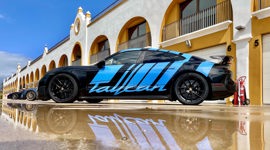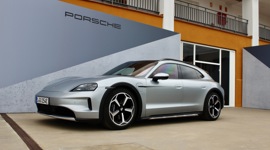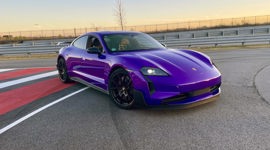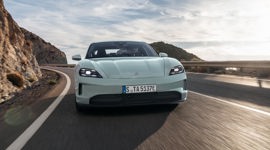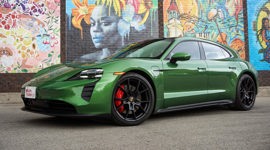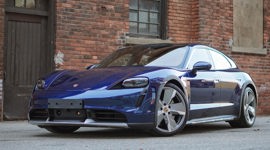 AutoTrader SCORE
AutoTrader SCORE
-
STYLING9/10
-
Safety8/10
-
PRACTICALITY8/10
-
USER-FRIENDLINESS6/10
-
FEATURES8/10
-
POWER9/10
-
COMFORT9/10
-
DRIVING FEEL9/10
-
FUEL ECONOMY9/10
-
VALUE7/10
Turn the clocks back just five years or so and Porsche would probably be one of the last manufacturers you’d bet would ever build an all-electric, off-roadable station wagon.
And yet here we are with the 2021 Porsche Taycan Turbo S Cross Turismo, an all-electric station wagon with black plastic fender flares, a so-called “gravel” mode, and a gold crest on the hood. It’s probably a direct result of its weirdly niche and specific premise that this long-roof Taycan may very well be the greatest all-rounder on the market right now. It’s practical, luxurious, unbelievably well-built, and – because this is the Turbo S – absurdly quick.
Styling: 9/10
As the long-time purveyor of the unconventionally packaged, rear-engine 911, Porsche has taken to designing a car around a big, flat battery and a lack of an internal combustion engine quite well. The Taycan is one of the coolest and most interesting-looking cars on the road today. It’s well-proportioned, voluptuous, and unmistakably Porsche.
In Cross Turismo guise, the car essentially gets the Subaru Outback treatment, gaining a wagon shape and some black plastic cladding around the edges. Whether or not a car like this would or should actually see gravel very often can be debated but on aesthetics alone, it exudes mild Mad Max vibes as a more utilitarian and rugged interpretation of a low-slung, sporting, luxury product. On the flip side, I’m not a fan of the relatively dowdy winter wheels or the boring grey paint that came on our tester; but, of course, those can both be fixed on the option sheet. (Gentian Blue with either of the 21-inch wheel options for me, please.)
Climbing inside, the Taycan’s interior exhibits a similar vibe, sporting a very futuristic interpretation of classic Porsche design cues, including a 16.8-inch instrument screen that’s shaped like the five-dial gauges of the 911 but curved like a Samsung gaming monitor. In fact, the entire dashboard looks very Porsche 911 but is, of course, covered in screens.
An aspect of the Taycan that can’t quite be communicated through photographs, however, is build quality. A much-maligned aspect of the electric cars made by Tesla, the Taycan feels like it was conceived as a direct answer to the Model S while taking that vehicle’s fit-and-finish issues as a personal affront. Pretty much every physical bit of the Taycan feels solid and well put together. All of the buttons and switches operate with a satisfyingly sharp click. The doors feel like they were forged and stamped out of a single piece; in fact, the whole car does.
Every surface, touchpoint, and shutline looks and feels like they were obsessed over by a squad of engineers at the top of their game. Because they probably were. Not only is Porsche’s build quality a step above Silicon Valley startup automakers and value-minded mainstream cars, but it’s also a step above fellow established German luxury makers like BMW and Mercedes-Benz.
Safety: 8/10
The Taycan Turbo S Cross Turismo comes standard with knee airbags for the front occupants, rollover detection, pedestrian detection, lane-keep assist, and traffic sign recognition. Opting for the $4,840 Premium package throws in, among other features, a surround-view camera system and parking sensors all around. The brand’s adaptive cruise control system will cost you another $1,780. It works well enough at keeping its distance but the lane-keeping function could stand to feel more natural, ping-ponging between the lines on the road. However, the system is intended to be used with your hands on the wheel, requiring steering input every 15 seconds.
Features: 8/10
In typical Porsche fashion, quite a few of this car’s creature comforts are locked behind a paywall of some magnitude but, as standard, the Taycan Turbo S Cross Turismo comes with ambient interior lighting, LED headlights, dual-zone automatic climate control with particle/pollen/active carbon filter, thermal insulating glass throughout, 18-way adjustable sport seats, heated seats for both rows, a heated steering wheel, wireless charging, two USB-C ports per row, and a 14-speaker, 710-watt surround sound system.
Our tester happened to be specced out with the $1,130 advanced four-zone climate control as well as the aforementioned Premium package, which also encompasses a fixed panoramic sunroof, thermal- and noise-insulating glass, and an onboard ioniser. The $4,550 Technology package includes a head-up display and an additional infotainment screen for the front passenger.
Less positively, the base sound system is a little underwhelming for a luxury car of this price. A 1,455-watt, 21-speaker unit is available for $6,620. Per Porsche’s website, a power adjustable steering wheel is standard equipment in the Turbo S but, due to parts supply issues, the wheel found in this particular car had to be adjusted manually. According to a Porsche rep, a customer car would be entitled to a free post-delivery retrofit once the relevant parts became available.
All in all, the Taycan Turbo S is a well-equipped car (as it should be, starting at $218,000) and can be had with pretty much any and all of the creature comforts provided your wallet is big enough to back it up.
User Friendliness: 6/10
The Taycan is hardly the first or only car, electric or otherwise, to stuff the cabin full of touch-based controls, but it just isn’t a very intuitive (or, frankly, well-conceived) place to make sense of as a result. The HVAC controls, for example, are all gathered in the vertically oriented touchscreen that sits between the front occupants but, for some reason, still require substantial button-like presses to do anything. The redundant touchpad below the HVAC controls is even worse to use than similar systems from Lexus and Acura, while not working at all with Apple CarPlay. There are no traditional volume or tuning knobs on the centre console, nor are there any dedicated buttons or scroll wheels for track-seeking. Even the air vents are adjusted via touchscreen only.
That main, central touchscreen is about a knuckle’s length too far away and is too bright at night even in its dimmest setting. Meanwhile, the software itself takes a beat to respond to every tap and is just not as snappy or intuitively laid out as the systems offered by BMW, Genesis, Mercedes, or even a bunch of mainstream automakers.
Practicality: 8/10
Size-wise, the Taycan occupies a weird space in between the BMW 3 Series class and the larger 5 Series. Ergo, back-seat space is decent but not overly generous, while that optional panoramic roof does a lot of work to make the cabin feel more airy. Notably, the Taycan comes standard as a four-seater, much like the Panamera. Our tester had a centre rear seat added as a $550 optional extra to make it a five-seater.
The Cross Turismo’s wagon body style naturally means a more usable cargo space with a bigger hatch-style opening. There is indeed a frunk, but the nook dedicated for storage is quite tiny, without much room for anything more than the car’s own charging cables and hardware.
Comfort: 9/10
The Taycan’s suspension and seats are best described as comfortably taut – substantial-feeling and communicative but never jarring. As standard, the steering wheel and rear seats are heated while the front seats are both heated and ventilated. Double-pane thermal- and noise-insulating glass keeps the outside world outside, making for a very quiet cabin. With the absence of a humming gas engine, wind noise is often an issue with EVs (even expensive ones like the Mercedes EQS) but not with the rock-solid Taycan.
Power: 9.5/10
The big story with the Taycan is, of course, its status as Porsche’s first and (for now) only all-electric car. Using dual electric motors, this range-topping Taycan Turbo S spits out 616 hp and 774 lb-ft of torque under normal circumstances but can temporarily amp it up to 750 hp when launch control is engaged. In its most drag-strip-ready setting, the electric Porsche wagon sprints from zero to 100 km/h in just 2.9 seconds – silently, reliably, and repeatably.
Combine that ability with the instant power delivery inherent to electric powertrains and this Taycan’s ability to thrust from civilized to felony speeds is slightly alarming and borderline God-like. See a gap in traffic? No need to wait for turbos to spool or fuel to combust, just prod the accelerator a bit and it’s yours.
Without a V8 or a flat-six roaring in front of (or behind) you, the Taycan Turbo S features an artificial flux capacitor-like noise that can be turned off. It’s cool for about five seconds before you realize how unnecessarily loud it is, and just not something I’d have switched on very often, if ever. And, as evidenced by the fact that this feature was disabled when I first picked the Taycan up, I’m clearly not the only person who feels this way. For what it’s worth, a similar albeit configurable system in the Mercedes-Benz EQS is implemented more subtly and just flat-out sounds more interesting.
Driving Feel: 9/10
As evidenced by the Taycan’s very weighty, serious inputs and near-perfect steering for a car of this type, the move to electric hasn’t taken away the ace driving characteristics that have made the Porsche brand iconic. Unlike with lesser EV makers, Porsche has been able to work around the altered inherent weight distribution of an electric car and have produced a chassis that just feels like that of an extremely well-engineered, gas-powered performance car. No bottom-heavy wonkiness here. Pair that instant, organ-rearranging thrust with extremely high, rail-steady cornering limits and every empty highway on-ramp becomes your own makeshift roller coaster.
Also bucking an EV trend is the absence of paddle-operated regenerative friction braking. There is one extremely mild regen setting mapped to a button on the steering wheel, but it isn’t nearly strong enough to facilitate any sort of one-pedal driving. (Which is probably for the best because, if you ask Porsche’s staunchest purists, that two-pedal driving ordeal was already a step too far.) And about that second pedal. Brakes – cross-drilled ceramics measuring 420 mm up front and 410 mm in the rear – are appropriately strong at-speed yet some of the easiest and smoothest stoppers I’ve used around town.
Fuel Economy: 9.5/10
The United States Environmental Protection Agency (EPA) officially rates the Taycan Turbo S Cross Turismo for the equivalent of 325 km of range. Upon picking the Taycan up with a nearly full battery, however, the car showed 375 km of range on its onboard indicator. This initial estimate only proved to be moderately generous, though, because after about 170 km of both regular and fairly aggressive driving, the car indicated just 167 km remaining with the battery at 43 per cent charge, an overestimation on the Taycan’s part by about 40 km (but still on track to outdo its own EPA rating by about 10 km).
As with any other EV that isn’t a Tesla, the public charging infrastructure isn’t great but still serviceable. Plugging the Cross Turismo into a 350-kW DC fast charger at a Petro-Canada station, I was able to go from 43 to 94 per cent juice in 36 minutes and for a little less than $12. Not bad at all. At which point the car indicated an even more-ambitious-than-before 388 km of driving range.
Value: 7/10
It may feel comical even reading the words “Porsche Taycan Turbo S Cross Turismo” and “value” in the same sentence but, truthfully, I do think this car’s sky-high price tag is justified. Starting at $218,000, our tester came with a fairly long list of optional extras that – paired with A/C tax and a non-negotiable destination charge of $1,500 – added up to a total of $238,690 before tax.
That’s certainly not an insignificant price, but when you look at the performance, tech, and sheer quality on display here, that number just about seems right. I mean, if the Taycan Turbo S goes like a supercar – and it does – it only makes sense that it’s priced like one, right?
The Verdict
As an electric vehicle, the 2021 Porsche Taycan Turbo S Cross Turismo is good, but not amazing. Its range is merely decent and it’ll charge fairly quickly (if you can find a public charger that works). But if those are the two key EV metrics you care about, you’d probably be better off with the competing Tesla, what with the Model S Plaid’s 560 km of advertised range and that company’s extensive Supercharger network.
As a car, however, it’s pretty darn excellent. It goes, handles, and stops like a Porsche should, and is built like one, too. It looks like nothing else on the road, while its wagon shape makes it almost as practical as any compact crossover out there. The fact that it’s silent, smooth, and efficient is just a bonus.
Yes, it’s infotainment system and various aspects of its interface can be improved but once you get used to all of its idiosyncrasies, the Taycan is a fabulous car. Whatever other cars you encounter in it out on the street, the Taycan Turbo S Cross Turismo is probably faster, quicker, smoother, better built, better to drive, quieter, or more practical. As an all-rounder, it may just be the greatest car on sale today.
| Engine Displacement | n/a |
|---|---|
| Engine Cylinders | n/a |
| Peak Horsepower | 616 hp (750 hp with Launch Control) |
| Peak Torque | 774 lb-ft |
| Fuel Economy | 3.2 / 3.2 / 3.2 Le/100 km cty/hwy/cmb |
| Cargo Space | 84 L front, 1,171 L rear w/ seats folded |
| Model Tested | 2021 Porsche Taycan Turbo S Cross Turismo |
| Base Price | $218,000 |
| A/C Tax | $100 |
| Destination Fee | $1,500 |
| Price as Tested | $238,690 |
|
Optional Equipment
$19,090 – Off-road Design Package, $2,480; Rear Seat in 2+1 Configuration, $550; LED Matrix Main Headlights Glacier Iceblue, $660; Light Strip with ‘PORSCHE’ Logo Glacier Iceblue, $970; Advanced Climate Control (4-Zone), $1,130; On-Board DC-Charger with 150 kW, $520; Mobile Charger Connect, $1,270; Porsche Intelligent Range Manager, $340; Premium Package, $4,840; Porsche InnoDrive including Adaptive Cruise Control, $1,780; Technology Package, $4,550
|
|










































